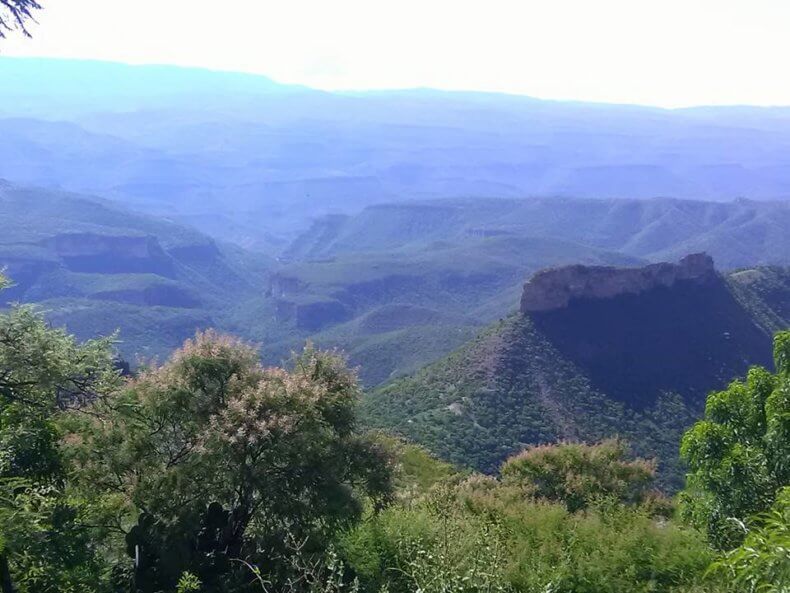
by Deep Green Resistance News Service | Sep 21, 2016 | Indigenous Autonomy, Reclamation & Expropriation
Featured image: The Wixárika community of San Sebastian Teponahuaxtlán or Wuaut+a is preparing to send 1,000 members to the remote Nayarit community of Huajimic to take back from the ranchers lands that the courts have ruled belong to the Wixárika. Photo from Facebook/San Sebastian Teponahuaxtlán.
by Tracy Barnett / Intercontinental Cry
A contingent of at least 1,000 indigenous Wixárika (Huichol) people in the Western Sierra Madre are gearing up to take back their lands after a legal decision in a decade-long land dispute with neighboring ranchers who have held the land for more than a century.
Ranchers who have been in possession of the 10,000 hectares in question for generations say the seizure is unlawful and that they will not hand over the land — setting the scene for a showdown that observers fear may end in violence.
Leaders of the Wixárika community of San Sebastian Teponahuaxtlán have announced their plans to accompany the authorities of the federal agricultural tribunal to carry out an enforcement action on the first parcel, a 184-hectare ranch in the state of Nayarit, on Sept. 22, and called on state and federal law enforcement officials to send police forces to prevent a conflict. Until the time of publication, neither the Nayarit nor the federal authorities had agreed to send police to maintain order, so both parties are hoping for the best but preparing for the worst.
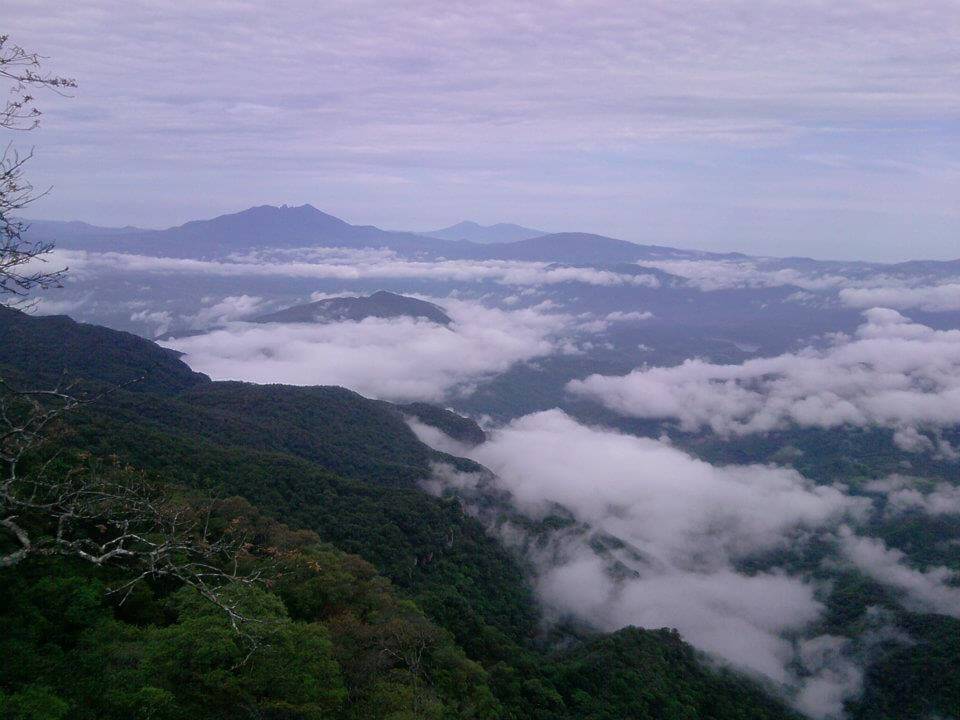
The Nayarit community of Huajimic in the municipality of La Yesca has a long tradition of ranching. Ranchers of Huajimic have titles to their land that date to 1906, but the courts have ruled that the Wixarika land claims go back to the Spanish land grant of 1717. Photo from Facebook/Huajmic, Nayarit.
“We’re hoping they’ll accept the decision which is now law: that they lost the trial. They had the opportunity to legally prove that they really had the documentation and they didn’t have it,” said Miguel Vázquez Torres, president of the communal lands commission of San Sebastian. He is aware of the potential for violence, he said, “but the community is not going to sit with its hands crossed. We are prepared.”
Ranchers have titles to the land that go back to the early 1900s — but San Sebastian has the original grant from the Spanish crown that dates to 1717, and is backed by a 1953 presidential resolution. In all, 10,000 hectares is at stake, for a total of 47 different claims. The agrarian court has ruled in favor of San Sebastian in 13 of those cases; the remainder are still in process.
Rosa Carmen Dominguez Macarty, an attorney representing some of the ranchers of Huajimic, disputes the version presented by Wixarika attorneys, saying that only two of the sentences are definitive, and that all the rest are still under appeal. The ranchers are appealing the 1953 presidential resolution, saying it is based on a document that is invalid.
“It’s a social injustice,” she said. “These are very simple people; they are fathers, they are mothers who work the land themselves, and that’s how they support their families. It would be really sad if through the government’s disregard, something unpleasant were to happen.”
Vázquez said that two families who have no land have already been granted permission by the community assembly to establish homesteads on the parcel and that the assembly plans to send a rotating contingent of community residents to stand guard for several months — “as long as it’s necessary so that the families can feel safe and comfortable.” The long-term plan, he said, is to establish another settlement in the area, as San Sebastian’s existing towns are becoming overcrowded.
Dominguez argued that the local inhabitants have worked the land for generations and turned it into a highly productive area. Local residents suspect the Huicholes have another ulterior motive for taking back the land, which they have never worked: to exploit the mineral deposits that supposedly lie beneath.

Members of the Wixarika community of San Sebastian Teponahuaxtlán protesting for land reform in Guadalajara in 2014. Photo from the Facebook/San Sebastian(Wuaut+a).
Complicating matters is that San Sebastian lies in the state of Jalisco, while the contested land lies in Nayarit, where the ranchers have been outspoken in their opposition to the court decision and have been organizing in resistance to the return of the land to the Wixárika.
“Jalisco vs. Nayarit: Blood will run,” screamed one headline in a Nayarit newspaper. Meanwhile, Nayarit Gov. Roberto Sandoval reportedly has sent messages of support to ranchers.
“The governor promised us that while he is in office, we would not have to turn over a single meter of land to the Huichols,” one of the landowners told local reporter Agustín Del Castillo of Milenio newspaper.
Indeed, it’s no accident that the conflict crosses state lines, according to anthropologist Paul Liffman, author of the book Huichol Territory and the Mexican Nation.
“In fact that’s the deep history of Jalisco and Nayarit,” Liffman said in a recent interview. “Nayarit was part of Jalisco, and it separated in 1917, in part for the ranchers who wanted more political autonomy and also wanted to kick out the Indians.”
During the early years of the 20th century, the government encouraged settlers to make land claims on apparently abandoned land. It was during that period that major encroachment began to occur on Wixárika land, and the courts granted titles based on the erroneous assumption (or pretext, as Liffman says) that the land was unoccupied.
Tensions have flared periodically since the land was taken but the Wixárika had no legal recourse until the government created an agrarian court system in the 1990s, said Ruben Avila Tena, the attorney representing the community of San Sebastian. Soon afterwards that community began a legal process of reclaiming its land.
Jalisco law enforcement has agreed to be present, but only up to the state line; thus far the Wixárika leadership has received no such assurances from the Nayarit authorities, nor from the federal government.
“I’m not sure what the Jalisco police can do, besides cheering them on from the other side of the border,” commented Avila Tena. “It’s actually a very worrisome situation.”
Avila said sources in the Agrarian Tribunal have told them that the Nayarit police have no intention of supporting the Wixárika on Sept. 22. Agrarian Magistrate Aldo Saul Muñoz López spoke to this reporter by telephone but said he could not grant an interview by telephone, only in person in the Tribunal regional offices in Tepic, Nayarit.
“We did what corresponds to us as a federal tribunal, we notified all of the relevant authorities of Nayarit. If they don’t respond, it’s something that escapes my authority,” said Muñoz López, but would not give further information by phone.
Liffman likened the current conflict in San Sebastian with one that arose in the 1950s under the Huichol leader Pedro de Haro. Haro built a movement that ultimately procured the 1953 presidential resolution confirming that San Sebastian was the legal owner of the land. But as in the present case, the government didn’t provide any enforcement mechanism, and the local residents refused to give up the land. A band of armed Huichols took the matter into their own hands and marched to the Canyon of Camotlán, where they reportedly burned down a farm, drove out local residents and reclaimed the land.

Photo from the Facebook pages of the community of San Sebastian (Wuaut+a).
Santos de la Cruz Carrillo, a Wixárika leader and also an attorney on San Sebastian’s legal team, said the community has been urging the federal authorities to attend to this case for five years under a program that would offer financial compensation to the current landholders.
“It’s been five years since the community of San Sebastian asked the federal government to attend to this situation, to support the landholders with compensation”, said de la Cruz. “But the ranchers showed no interest in the compensation; they always said they want the land, so the community chose to take possession.”
Finally, in a meeting in March of this year, an official with that program told San Sebastian authorities that there was no money to pay restitution to the ranchers. That’s when they made the decision to move ahead with the process of retaking the lands, said Avila.
The Wixárika authorities have done everything in their power to seek compensation for the ranchers in the hope that a conflict could be avoided, said Avila. “This case was decided in their favor more than two years ago,” he stressed. “The community didn’t want it to be enforced like this, they were trying to get the federal government to indemnify the landholders. When they couldn’t do that anymore, they said, it can’t be helped, we will have to ask the tribunal to enforce the law.”
Liffman warned that the situation was not to be taken lightly; the area has changed radically since the times of Pedro de Haro, he said, with a significant amount of drug production now occurring throughout the territory.
“The region has become much more heavily armed,” he said. “San Sebastian has been the most violently disputed area in the sierra over the past several years…. it’s big-scale transnational narcos now, it’s not just some ranchers with pistols on their belts. So if it does come to that, it could be a bloodbath.”
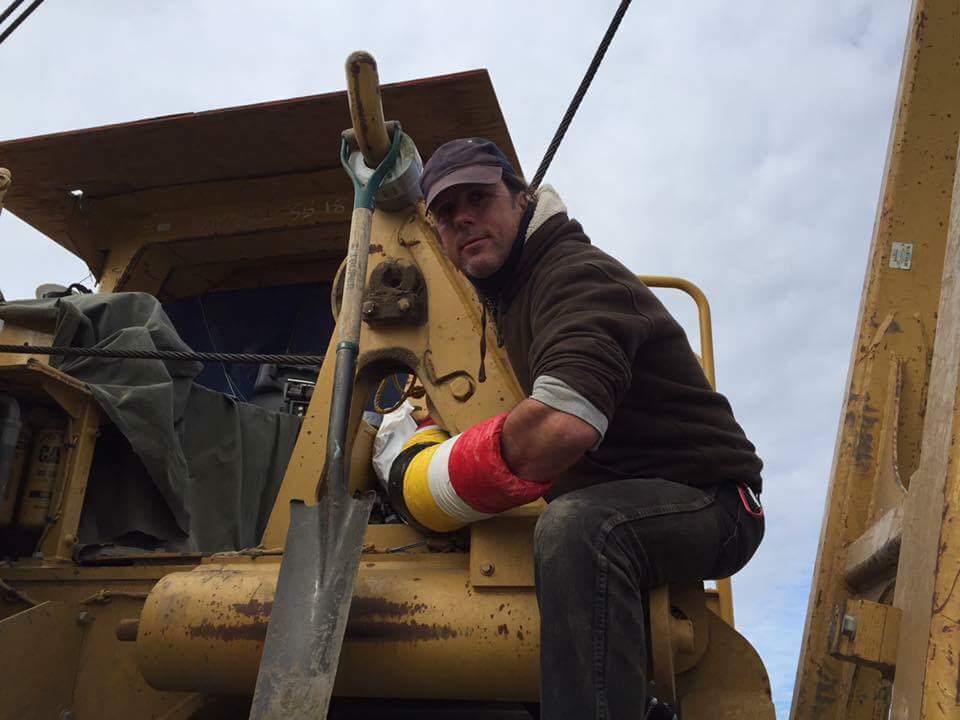
by Deep Green Resistance News Service | Sep 15, 2016 | Obstruction & Occupation
by Red Warrior Camp
Mandan, ND… Water protectors stopped construction at two Dakota Access Pipeline sites on September 13, northwest of Mandan through nonviolent direct action.
At approximately 10:30 a.m. CST, two water protectors “locked down” to heavy equipment at the first action site. One of the individuals was locked onto the machine for nearly 7 hours.
Trained medics, media, legal observers and police liaisons were on hand to offer support and were also arrested.
Separately, water protectors successfully and peacefully stopped construction at the second site. A worker pepper sprayed one of the water protectors before leaving the scene.
Law enforcement began to arrive within the hour, followed by a large bus load of police dressed in full riot gear. An initial police line was formed with officers toting pellet guns. Filing in behind them was a second line of officers pointing large semi-automatic rifles at the water protectors.
The water protectors were immediately told that they were trespassing and subject to arrest. Morton County Sheriff’s office confirmed that there were 22 water protectors in custody by 4:00 p.m. The majority of those arrested are charged with Criminal Trespass, a Class B Misdemeanor.
The two individuals who locked down to the equipment are charged with Criminal Trespass, Disorderly Conduct, and Obstruction of a Government Function.
The Morton County Jail booking process of the water protectors continued on into the evening hours. Jail officials informed the Camp’s legal team that the ND States Attorney, Al Koppy, had ordered that only a North Dakota licensed attorney could visit the jailed water protectors, which is a violation of their constitutional right to counsel of their choosing for initial consultation.
The volunteer legal team assisting the water protectors called upon Chad Nodland, a local attorney who was also met with resistance by Morton County Jail staff. Although some of the inmates had been processed, the jailers informed Nodland that he would have to wait until all 22 arrested were processed before he could speak to them individually.
Morton County Sheriff’s Office refused to comment at press time. The water protectors’ bond hearing is scheduled for 1 p.m. CST on Wednesday, September 14th at Morton County Court House in Mandan, ND.
To support supplies for the Camp and the ever-increasing legal costs from the Red Warrior Camp please visit our website and click on DONATE.
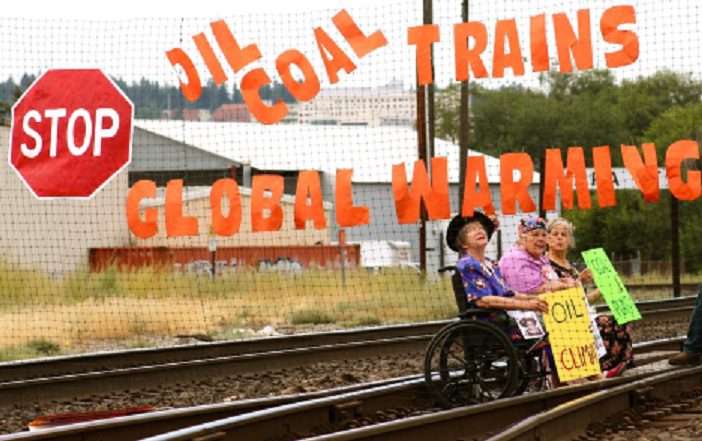
by Deep Green Resistance News Service | Sep 3, 2016 | Obstruction & Occupation
By Direct Action Spokane
Shortly before noon on August 21, a group of Spokane citizens occupied BNSF railroad tracks to protest the transport and eventual burning of fossil fuels in defense of climate change. The peaceful, non-violent direct action consisted of 30 protesters and eventually three arrests. The three people arrested were Nancy Nelson, Margie Heller, and Deena Romoff, all of whom are associated with the group Raging Grannies – an activist group dedicated to nonviolence in the name of social and environmental justice. The charges against each are obstructing a train and misdemeanor trespass.
Today’s action in Spokane blocked a number of rail lines including an empty oil car train headed east and a fully loaded coal train headed west. The track occupation stopped all rail traffic for over one and a half hours.
“There is incredible denial surrounding this issue of fossil fuels and no one is talking about the perils that await us if government and societies do not take action now,” said Deena Romoff, one of the arrestees, in a written statement that she read during today’s protest. “This is why I need to take action now…I can no longer wait!”
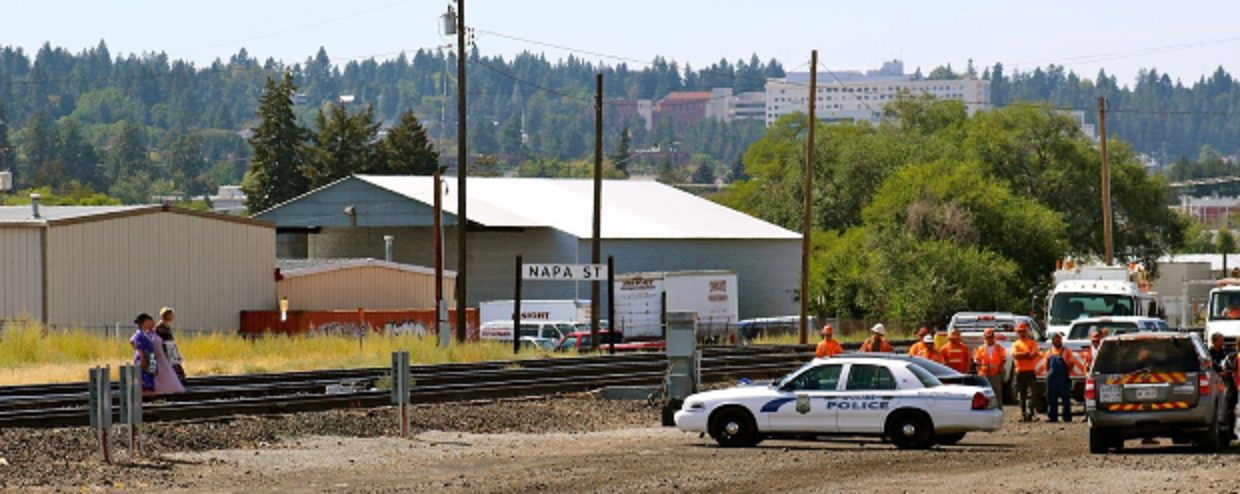
Trains from BNSF, Union Pacific, and Canadian Pacific that pass through the city and county of Spokane carry Bakken crude oil from North Dakota, Tar Sands crude oil from Canada, and coal from the Powder River Basin in Montana and Wyoming. The crude oil is bound for refineries in the Northwest and Canada and will eventually be burned domestically and internationally. The coal is bound for export terminals in the United States and Canada for shipment to Asia to be burned in coal-fired power plants.
“Transporting fossil fuels is done for one purpose only: they will be burned”, said Margie Heller in a prepared statement. “If burned, they will add to the greenhouse gases which are already causing serious climate change. Continuing to add to climate change factors puts the health and perhaps the very existence of future generations at risk”
Direct Action Spokane stands in solidarity with on-going actions around the country working to stop the extraction, transportation, processing, and burning of fossil fuels. Direct Action Spokane is also committed to stopping the transport of oil and coal trains through Spokane and calls on other communities, up and down the rail line, to do the same.

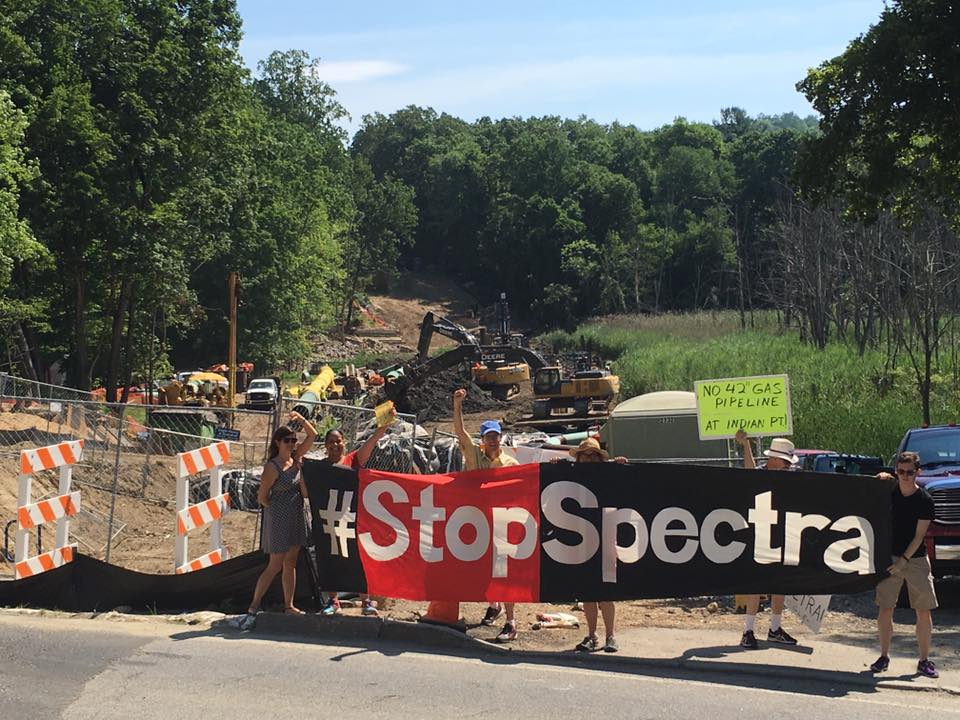
by Deep Green Resistance News Service | Aug 30, 2016 | Obstruction & Occupation
By ResistAIM
Brooklyn, NY – Concerned New Yorkers blocked the doors of National Grid’s downtown Brooklyn office at noon on Monday, August 29 to protest their support of Spectra Energy’s AIM Pipeline, a -brooklyn-demanding-national-grid-stop-support-spectra-energys-dangerous-aim-pipelinehigh-pressure methane gas pipeline that will bring fracked gas from Pennsylvania to New England. Members of 350Brooklyn.org, 350NYC.org, and ResistAIM came together to demand that National Grid end their contract agreement with Spectra Energy. The pipeline’s route runs 105 feet from infrastructure critical to the Indian Point Nuclear Power Plant in New York’s Westchester County. “National Grid is risking the safety of the 17 million people who live within 50 miles of the aging Indian Point reactor so it can sell gas in other parts of the country and the world,” says Mimi Bluestone of 350Brooklyn, one of eight people arrested as part of the day’s action. “Our governor and our US senators have called on the federal government to withdraw its authorization for this pipeline. But without National Grid’s end-of-pipeline agreement to buy this gas, the project could not be economically viable.”
Both elected officials and local residents have repeatedly raised concerns about the pipeline’s safety. This past February, Governor Andrew Cuomo asked the pipeline’s builder, Spectra Energy Corp of Texas, to suspend the project pending an independent safety analysis. “The safety of New Yorkers is the first responsibility of state government,” Cuomo said in making the request. In May, New York Senators Chuck Schumer and Kirsten Gillibrand asked the Federal Energy Regulatory Commission, which has jurisdiction over the pipeline, to halt construction pending such a study. Spectra Energy and FERC have denied the governor’s and the senators’ requests.
The AIM (Algonquin Incremental Market) pipeline is designed solely to deliver natural gas to New England; New York is simply a “pass through” state. The pipeline will enter New York in Rockland County, pass under the Hudson River, and then cross Westchester County en route to Connecticut. Built in the 1970s, Indian Point Nuclear Power complex remains active and contains decades of spent radioactive nuclear fuel, while over 17 million people live within 50 miles of Indian Point. National Grid, a British multinational, expanded into the United States beginning in 2000 by buying a number of local utilities in New England and New York, including the successor to Brooklyn Union Gas. It is a major potential customer for the natural gas that the AIM pipeline would transport to New England and so has the power to determine the financial viability of this project. Last week, National Grid withdrew its petition for a 20-year contract on Spectra’s Access Northeast project; however, National Grid is still expected to purchase gas flowing through the AIM Pipeline and so activists in Rhode Island, Massachusetts and New York are continuing to call on National Grid to cancel the contract.
The AIM pipeline is scheduled to be completed in November 2016, which calls for immediate action. On Monday evening, following the arrests at National Grid, concerned New Yorkers are gathering at the Brooklyn home of Senator Charles Schumer to encourage him to stand with New Yorkers by making a public appearance to denounce the pipeline and calling for a Government Accountability Office (GAO) investigation of the Federal Energy Regulatory Commission – more details can be found HERE.
350.org is a national organization working to keep carbon in the ground and to build a new, more equitable low-carbon economy. Its affiliates like 350NYC and 350Brooklyn work on local issues related to climate change. ResistAIM is a coalition of environmental advocates, Westchester residents and concerned New Yorkers that have been taking nonviolent direct action to stop the AIM Pipeline since November 2015.
A map of the AIM pipeline’s route: http://www.spectraenergy.com/Operations/US-Natural-Gas-Operations/New-Projects-US/Algonquin-Incremental-Market-AIM-Project/
A map of the pipeline’s proximity to the Indian Point Nuclear Power Plant: https://sape2016.org/2015/07/16/nuclear-regulatory-commission-withheld-and-misrepresented-critical-information-used-to-evaluate-and-approve-the-siting-of-the-spectra-aim-pipeline-alongside-indian-point/
For Cuomo’s position: http://www.bloomberg.com/news/articles/2016-02-29/cuomo-seeks-halt-of-spectra-algonquin-gas-line-for-safety-review
For Senator Gillibrand and Schumer’s position: https://www.gillibrand.senate.gov/newsroom/press/release/schumer-gillibrand-urge-ferc-to-suspend-construction-on-aim-pipeline-expansion-until-independent-health-and-safety-studies-are-conducted
For 350NYC: https://350nyc.org/
For 350Brooklyn: http://350brooklyn.org/
For ResistAIM: www.resistaim.com

by Deep Green Resistance News Service | Aug 27, 2016 | Obstruction & Occupation
By Deep Green Resistance Seattle
A coal train entering Bellingham, Washington has been blockaded by a fossil fuel resistance group, including members of Deep Green Resistance. This blockade, part of an ongoing regional campaign against fossil fuels, has been standing strong for six hours – with no end in sight.
Beginning at four PM this afternoon, protestors erected a portable tripod structure in the middle of a rail bridge crossing Mud Bay south of Bellingham. One protester has climbed to the top and will stay until removed by police.
The organizers of the blockade say that fossil fuels must be stopped to save the planet from global warming.
When asked about her motivation for joining the resistance movement, one Deep Green Resistance member responded, “We won’t be complicit in a global catastrophe. The government and the capitalists are working together to kill the planet. We’re going to work together to stop them.”
With two refineries sitting north of town and a tar sands pipeline running underneath, Bellingham has been in the sights of the fossil fuel industry for decades. The struggle to keep fossil fuel transportation out of the small city has been ongoing. The Lummi Nation and other local resisters recently defeated plans for a major coal export terminal. However, coal merchants continue to push for the project.
The protest also delayed passenger trains, but organizers aren’t overly concerned. When asked about possible inconveniences to travelers, a protestor responded, “What’s inconvenient is losing your island to rising sea levels, or having your home flooded in Baton Rouge, or digging mass graves in Pakistan in anticipation of heat waves.” She also noted that Amtrak was notified to minimize delays in passenger transportation.
From Deep Green Resistance Seattle: http://deepgreenresistanceseattle.org/resistance/direct-action/activists-stage-coal-train-blockade-bellingham-train-stopped-5-hours-counting/

by Deep Green Resistance News Service | Jul 27, 2016 | Direct Action
By Will Falk / Deep Green Resistance
This year’s Fourth of July week grew in horror as it passed. Each day brought new nightmares that struck me at a dizzying pace. By the end of the week, after I decided I was sick of weeping, I turned off the television, shut my Facebook tab, and remembered that the best antidote for despair is action.
My week started hopefully enough in Eugene, Oregon where I participated in a training hosted by members of Deep Green Resistance called Extraction Resistance: A Three Day Training in Direct Action. One of the goals of the event was to normalize direct action tactics, and I was asked to write a primer on the topic. This is that primer.
When I got home from Eugene, I found a video news story from Karachi, Pakistan showing men digging mass graves in anticipation of the number of heat-related deaths caused by soaring summer temperatures. The ghosts of people not yet dead climbed from trenches dug in the dry Pakistani dust. I could almost see the bodies piling in the grave-diggers’ shadows.
The next day I watched as two white police officers pinned Alton Sterling, a black man, to the ground, put a pistol to his head, and shot him execution-style. I went to bed wondering how the cops were going to get out of this one only to wake to see Philando Castile slumped over in the seat of a car, blood seeping through his clothes, as his fiancé, Diamond Reynolds, explained in a video that Castile was just shot four times by a police officer in a routine traffic stop.
Then, during an otherwise peaceful rally protesting the murders of Sterling and Castile, twelve cops were shot, five of them fatally, and two civilians wounded by Micah Xavier Johnson, a military veteran who had served in Afghanistan. The Dallas Police Department then killed Johnson with a robot bomb.
Now, I am white, and I will not comment on the efficacy of Johnson’s actions. I will, however, direct a suggestion to white people who benefit from the white supremacism that the United States is founded upon and perpetuates. Let me suggest that the same culture producing climate change is the same culture producing the cops who murdered Sterling is the same culture producing the cops who murdered Castile is the same culture that trained Johnson “to shoot and move” is the same culture that employs police departments who possess robots with bombs that can be remotely controlled to kill citizens.
Let me suggest to those white people who are truly interested in undermining racism and stopping white supremacy that to do this we must dismantle the dominant culture. If we want to live in a world where Pakistanis are not digging mass graves for the victims of climate change, if we want to live in a world where people of color are not being murdered by cops, if we want to live in a world where veterans are not sniping from parking garages, if we want to live in a world where humans are not made into veterans in the first place, then we must look to the roots of the problem. Finding those roots, we must dig this poisoned tree out.
And, how do we dig these roots out? The answer begins with serious, militant resistance movements that correctly identify the dominant culture’s sources of power. Once those sources are identified, resistance movements must engage in direct action to undermine the dominant culture’s power.
***
First, we need to understand power. Quite simply, power is how the powerful do what they do. Power is how the cops murder and get away with it. Power is how corporations extract fossil fuels, burn fossil fuels, and drive the planet ever-closer to runaway climate change.
Power is best understood as a physical phenomenon. Power is not merely a mental event. Power is not simply an emotion. Cops may or may not personally hate the people of color they are murdering. Corporate decision makers may or may not personally despise the Earth that gives them life. What matters is that cops are armed with real batons, real pepper spray, real tasers, and real guns and they are supported by an entire governmental system that can protect them with even more batons, pepper spray, tasers, and guns. What matters is corporations are armed with real machines, real poisonous chemicals, real labor forces, and once their projects have been granted permits by the government, they can call on real cops with all the real weapons I’ve already described to protect their projects. What matters is physical power in the real world.
There is perhaps no person on Earth who has spent more time understanding the importance of power in contemporary politics than Gene Sharp. There is also perhaps no person in the world responsible for more successful revolutions than Sharp. This is no coincidence.
Sharp describes his theory of power in his brilliant book, How Non-Violent Struggle Works. His work helps us identify the dominant culture’s sources of power and provides insight into how those sources of power can be undermined.
Sharp begins by explaining the central importance of power, and writes: “Power is inherent in practically all social and political relationships. Its control is the basic problem in political theory and in political reality. It is necessary to wield power in order to control the power of threatening adversaries.” In short, the goal of any serious resistance movement should be to undermine the opposition’s power while enhancing the movement’s power.
Sharp defines political power as power “which is wielded for political objectives, especially by governmental institutions or by people in opposition to or in support of such institutions. Political power thus refers to the total authority, influence, pressure, and coercion which may be applied to achieve or prevent the implementation of the wishes of the power-holder.”
According to Sharp, the sources of political power are authority, human resources, skills and knowledge, intangible factors, material resources, and sanctions. These sources of power are interconnected and benefit and build off each other. Increasing power through one of these sources often enhances power in all the sources. This truth, while scary, also highlights weaknesses in the dominant culture’s power. If a resistance movement can undermine one source of power, it can deal a heavy blow to the others.
Sharp quotes Jacques Maritain to define authority as “the right to command and direct, to be heard or obeyed by others.” Taking this idea deeper than Sharp does, I want to point out that rights mean nothing if they are not enforceable. On the surface, it is easy to confuse the right to command and direct bestowed upon elected leaders, in the United States, as being derived from the results of an election. This is not completely true. Think, for example, what would happen if Barack Obama refused to yield the Oval Office to the winner of this year’s presidential election. Eventually, a governmental decision-maker would order police or soldiers to remove Obama at gunpoint.
Sharp describes how power is derived from human resources with, “The power of rulers is affected by the number of persons who obey them, cooperate with them, or provide them with special assistance.” These human resources come with the next source of power: skills and knowledge. Sharp writes, “The power of rulers is also affected by the skills, knowledge and abilities of such persons, and the relation of their skills, knowledge and abilities to the rulers’ needs.” Understanding this point, we see why the dominant culture is so obsessed with developing science and technology. It uses science and technology to enhance control. We see, too, why Western science has been a disaster for life.
Next, Sharp describes intangible factors as “Psychological and ideological factors, such as habits and attitudes toward obedience and submission, and the presence or absence of a common faith, ideology, or sense of mission.” To illustrate this point, imagine if rulers could convince people that this world isn’t real, that the sacred exists in an abstract sky God, and that the point of life is to suffer in this world to prove your devotion to this abstract sky God so you can join him, after death, in his abstract sky kingdom.
For material resources, Sharp writes, “The degree to which the rulers control property, natural resources, financial resources, the economic system, communication, and transportation helps to determine the limits of their power.”
To supplement Sharp’s analysis, here, we see one reason why the dominant culture is hell-bent on ecological destruction. Resource extraction yields power. Industrial agriculture – which requires the displacement of indigenous peoples, the extermination of animal populations, the theft of water from natural communities, deforestation, and the destruction of the world’s most important carbon sinks (grasslands) – yields a controllable food source. Mining – which also involves the displacement of indigenous peoples, the extermination of animal populations, the poisoning of groundwater, and mountain-top removal – yields energy sources for industrialization. And these are just two examples.
Sharp quotes John Austin to define sanctions as “an enforcement of obedience” and writes, “Sanctions are used by rulers to supplement voluntary acceptance of their authority and increase the degree of obedience to their commands…Violent domestic sanctions, such as imprisonment or execution, are commonly intended to punish disobedience, not to achieve the objective of the original command.”
We see, here, one of the primary roles of the police. Police exist to enforce obedience. Part of enforcing obedience is the performance of violent domestic sanctions like imprisonment and execution. To understand how this works think about a saying from the battered women’s movement: “One beating a year is enough to keep a woman down.” For a battered woman, it’s enough to keep her down that she merely be threatened with violence once she has experienced a man’s violence. The same is true for would-be resisters. After seeing videos of police murdering citizens, it only takes the threat of police violence to keep us in line.
***
Understanding that power is physical and identifying the material roots of the dominant culture’s power is only the first step. Now, we must act to physically dismantle those sources of power. Physically dismantling power requires direct action.
So, what is direct action?
The term “direct action” has been used so often within environmental and social movements in so many different contexts that it is in danger of losing its meaning. It is difficult to find a clear definition of direct action in activist literature rooted in a radical analysis, so I have formed my own. It has three parts: First, direct action involves a clearly defined and obtainable goal. Second, the success of that goal is demonstrable by a quantifiable reduction in the opposition’s physical power. Third, it is primarily the actions of those engaging in the direct action that produce the desired goal.
It is important that a proposed action begins with a clearly defined and obtainable goal because an action involving a poorly-defined goal makes it difficult to determine the scope of the action. And, proposed actions with unobtainable goals will be, by definition, ineffective. Planning to change the world through an educational program designed to illustrate the evils of the fossil fuel industry, for example, is neither clearly-defined nor obtainable. What does it mean “to change the world?” And, how will you possibly reach enough people to effect this change? Planning to delay the construction of a pipeline for a day, however, is both clearly-defined and obtainable. Resisters can, without too much imagination, envision a successful action.
Once a clearly-defined and obtainable goal is established, the direct action must reflect an understanding of power and be designed to materially affect the opposition’s physical power. Let’s say activists come up with a plan to drop a banner that says “Stop the Tarsands!” from the rafters of the Utah State Capitol. The plan is both clearly defined and, with some clever security dodging, obtainable. This action cannot be considered direct action, however, because there is no way to quantify how, or even if, the banner affects those in power’s ability to destroy.
Let’s look at another hypothetical plan: Activists plan to blockade, for 24 hours, trains carrying oil through the State of Washington where they will be loaded on to tankers to fuel the US Navy in Hawai’i. This plan has a clearly defined and obtainable goal. The goal also reflects an understanding of where the dominant culture gets its power. The US Navy, one of the weapons the United States uses to perpetuate imperialism, literally requires oil. Depriving the Navy of a little oil for one day may not be a big hit to its power, but it is quantifiable.
It is primarily the actions of those engaging in the direct action that produce the desired goal. Another way to say this is: There is a clear causal link between the direct action and the desired goal. If the goal is to block the construction of a pipeline, for example, then the planned action must literally stop the pipeline’s construction. If the goal is to liberate individual children from human trafficking networks, then the planned action must literally involve the means to escort children from human trafficking networks to safety. Yet another way to say this is: direct action does not leave it to external decision makers (governmental, corporate, or otherwise) to produce the desired goal. Direct action is not an appeal to those in power. It does not rely solely on moral persuasion, shame, or economic cost-benefit analyses.
A lawsuit, then, that is filed to gain protection for a species that lives on land where a mine is planned to be dug in order to stop the mine has a clearly defined and obtainable goal. If the lawsuit is won, then it will materially affect one of the dominant culture’s sources of power. But, this lawsuit is not direct action because it relies on a favorable ruling from a judge for its success. The actions of the lawsuit’s planners are necessary, but ultimately the planners themselves cannot produce the desired goal.
***
I’ve called this essay a “primer.” One definition of primer is “a short informative piece of writing.” Another is a “compound used to ignite an explosive charge.” I hope that this essay serves as both. We need to see the problems we face clearly and we need a spark to ignite the change that is so drastically needed.











